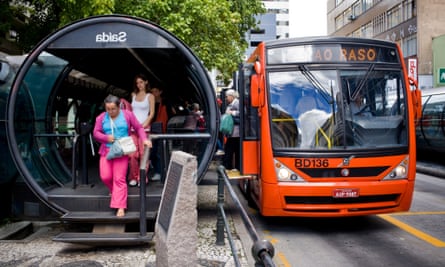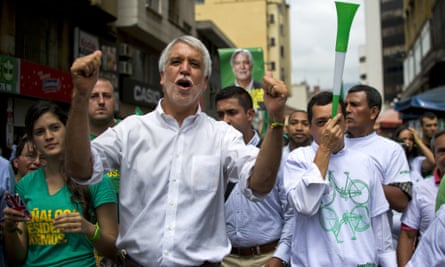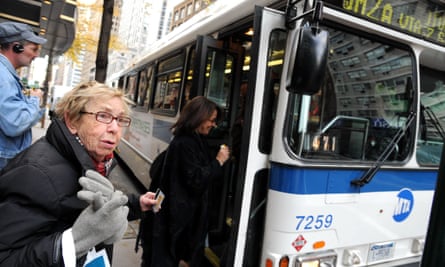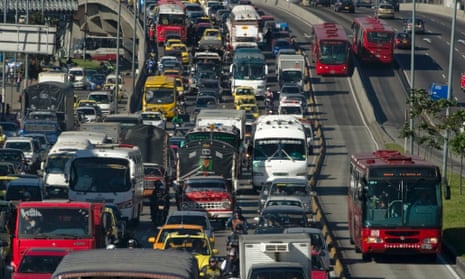“Buses! Buses! Buses! Buses!” thundered the tall man, rapping the cafe table between us, the cutlery threatening to vibrate right off the edge. It was October of 2013, we had just tucked into lunch on the first day of the Urban Age conference in balmy Rio de Janeiro, and the tall man was arguably the single human being most associated with the bus as a vehicle of urban redemption, Enrique Peñalosa. Alongside us, Alejandro Echeverri, a respected Colombian architect, had just dared to suggest that some municipalities might benefit from a metro system, and Peñalosa was having none of it.
Former mayor of Bogotá, maximum patron of that city’s famously successful TransMilenio bus rapid transit (BRT) network, Peñalosa now makes the rounds of such conferences (and they are many) arguing for the economic virtue and transformative potential of the not-so-humble bus. For the man fond of defining an advanced city not as “one where the poor move about in cars [but] where even the rich use public transportation”, the future of public transportation could only mean one thing, and that thing was BRT.
As it happens, innovation in urban affairs has developed a distinctly Latin flavour of late. From Porto Alegre’s experiments in participatory budgeting to the cable cars of Caracas, this most urbanised of regions would appear to have quietly stolen a march on the rest of the world. Latin American cities have found great success by deploying existing techniques (material or social) at relatively low cost, in unexpected and startlingly effective new combinations – precisely the manner in which Brazilian and Colombian cities have forged a high-capacity mass-transit system from the lowly city bus.
That such a seemingly dowdy way of getting about town should enjoy this kind of currency and intellectual respectability might seem a surprise. Aren’t we meant to be chattering excitedly about the self-driving car? Even to many Londoners, blessed with the world’s pre-eminent public transit system, the ponderous bus is an emblem of all that is slow, inefficient, socially stigmatised and retrograde in city life – more a thing of the past than the bold urban future. But such notions fail to take the measure of BRT.

At its core, bus rapid transit is a brilliant act of urban sleight-of-hand. Originally devised by Curitiba’s inspired architect/mayor Jaime Lerner in the oil-shock year of 1974, BRT is all about the art of doing more with less – much less. Its performance lies in recognising three facts: that a surprisingly large percentage of traffic congestion in cities is caused by the turgid movement of buses; that most of the delay comes from buses loitering at stops during the boarding phase; and that swift boarding, in turn, is hamstrung by the need of each rider to pay one by one, as they board.
Lerner’s solution in Curitiba was to lift the buses up and out of the ordinary flow of the streets, segregating them on dedicated high-speed lanes and freeing up road space for other traffic. The problems with boarding were solved by asking passengers to pay for trips before the bus even arrived, on entering specially designed, fully enclosed above-ground stations, which have since become iconic of the city. All of this proved not only much quicker and easier to implement than any buried transit system, but – particularly appealing to a cash-strapped administration – vastly cheaper as well. Curitiba-style BRT showed that a relatively low-cost, bus-based infrastructure could move masses of people through a city with the speed and capacity of a much more expensive metro system, while maintaining a flexibility no metro can ever muster.
Although it took three decades, and more-or-less successful implementation in a succession of Latin American cities (including Medellín, Quito, and Porto Alegre) before the world at large paid serious attention, it would appear that BRT’s moment has, at long last, arrived. A chart produced by the sustainable transport advocates Embarq claims that 181 cities worldwide now offer some form of “bus priority system” (though it’s unclear how many are true BRT, complete with dedicated lanes and stations, and how many merely some elaboration on the conventional express bus).
And no wonder. A properly designed BRT system can push a greater number of passengers over more kilometers of roadway, faster and for lower cost, than any other available transport technology – while at the same time relieving roadway congestion, and at least some of the harm to air quality that invariably goes along with it. A system that is truly embraced by its riders can have other benefit as well, beyond the logistics: after just six years in operation, a Lincoln Institute of Land Policy study found that the value of residential property along TransMilenio’s corridors had increased by up to 17%. (Those are crazy numbers; New Yorkers will know what I mean when I say “High Line numbers”.) To the administration of any given mid- to large-sized city, constrained in every direction and under the most intense pressure to put up results, the proposition must be hard to resist.

It has also, of course, historically been the case that the successful launch of a BRT scheme does great things for the public profile (and future electoral prospects) of a mayor. Consider the career trajectories of Lerner, twice elected governor of Paraná state, Quito’s Jamil Mahuad, elevated to the Ecuadorian presidency largely on the strength of his perceived role in the successful Trolebús system, or indeed Peñalosa himself, who has gone to enjoy a celebrated second act as a kind of globetrotting patron saint of public transport. (That both Lerner and Mahuad were later jailed for unrelated acts of corruption should in no way tarnish their public transport accomplishments.) Given this record, shepherding a BRT system to deployment may be the ultimate way for a mayor to do well by doing good.
But is BRT the urban panacea its advocates believe it to be? Peñalosa is fond of quoting figures suggesting that the 388km TransMilenio system, when complete, will cost little more than a proposed metro network that would have laid just 30km of track — and served only the already privileged. On this point, at least, US Transportation Review Board numbers support him, comparing the average cost of BRT, at nearly $3m dollars per km, to light rail at $70m.
Such figures may not add up to much. According to the Bogotá-based transport experts Diana Barco and Doris Tarchópulos, only a third of the proposed 388km has actually been built out; two additional phases have languished in developmental stasis, making projections of low-cost purely speculative. The focus on TransMilenio’s impressive economies, as well, tends to overshadow just who shoulders the cost: at 1700 pesos (50p) for a single ride, it can be prohibitively expensive for workers for whom that might represent a third of their daily wage. Despite this, Transmilenio is also a victim of its own success: its buses can be so densely packed with riders that it can be effectively impossible not only to board them, but even to disembark at the desired stop. Bogotános’ frustration with these issues exploded in a series of riots, the most recent of which, in March 2012, left five of the system’s stations “completely destroyed”.
While so far, at least, none have sparked riots, BRT systems outside Latin America have problems of their own. South Africa is a case in point: since 2010, both Cape Town and Johannesburg have invested in BRT schemes, yet both have struggled to attract passengers and meet their financial targets. Edgar Pieterse, director of the African Centre for Cities at the University of Cape Town, says the predominant spatial condition of South African cities, low-density suburban sprawl, does not make particularly suitable terrain for BRT, which requires continued and very high rates of occupancy to sustain itself economically. In the arcane economics of transport planning, the relevant figure is known as the IPK, or index of passengers per kilometer. The World Bank considers that only systems with an IPK above 10 are likely to remain financially viable; the publicly available IPK figure for Johannesburg’s Rea Vaya stands at 2.
Perhaps such systems would work better in a more densely settled landscape, then – somewhere like New Delhi? Not so much, as it turns out. According to a July 2012 report [PDF] from the Indian government’s Central Road Research Institute, the failure of a pilot BRT system there was overdetermined by several features of the local physical and cultural environment, including inadequate road width, unmaintained lane dividers, unpenalised use of the BRT lane by private cars and the widespread practice of parking on lanes reserved for traffic.

It might sound as though these are issues endemic to cities of the global south, from which any transit system in the developed north would presumably be free. But consider my native New York City, where the Metropolitan Transit Authority has operated a rather half-hearted take on BRT since 2008. Dubbed Select Bus Service, or SBS, the MTA’s version forgoes just about everything that would appear to be definitive of the concept, such as dedicated stations and lanes, and simply asks its passengers to buy their (paper) tickets at machines distinct from those that vend the more common MetroCards. At the stops themselves, confusion reigns. Though the MTA claims a 14-19% improvement in rush-hour travel times for its First and Second Avenue SBS routes, at least half the time a local bus shows up before the Select bus; panicky, already late passengers flock to it, waving their paper stubs at the driver, who has no choice but to accept them. Nor are local buses, by any means, the only vehicles that share the lane with the SBS fleet, which must also contend with taxis and “black cars”, the delivery vans of UPS and FedEx, even cars parked opposite a Starbucks while their drivers dash in for a latte. Not one of these impediments to bus-lane flow may be as picturesque as, say, a loitering cow or a rickshaw driver sleeping on his handlebars, but the impact they have on the system’s ability to perform as intended is nevertheless the same. About the only aspect of SBS that really does work like true BRT is the rapid boarding through multiple doors – and while that, it must be said, is very pleasant indeed, in itself it hardly constitutes robust proof of the concept’s viability on North American streets.
Even in Bogotá itself, Barco and Tarchópulos suggest that not everyone has quite adapted to the culture of bus rapid transit. The idea of planning routes and walking to fixed bus stops remains stranger to many Bogotános than the old, convenient way of sticking out their hand to hail a passing bus, wherever they happened to be standing. That this “old way” may, in an odd irony, be where the future of mobility is headed anyway (the wave of a hand merely supplanted by a smartphone app), does little to change how difficult it can be for many people to adapt.
Given all of these stumbles, it can be easy to forget why so many transportation planners and advocates were so excited about BRT to begin with. And it certainly does seem strange that Transmilenio received a “Gold Standard” certification [PDF] (with a score of 93 out of a possible 100 points) from the US-based Institute for Transportation and Development Policy, even as the people who knew it best, its riders, were going to the barricades to protest its failings. But it’s important to remember that BRT really has been enormously successful in cities across Latin America – speeding commute times, significantly improving air quality, reducing the toll of vehicular injuries and fatalities, even generating hundreds of millions of dollars in direct carbon credits – and promises the same elsewhere if implemented correctly.
And while it can admittedly be difficult to discern their virtues from, say, the back of an ancient 22-Fillmore crawling across San Francisco’s 16th Street, buses do things for our communities no Uber limo or self-driving podcar can ever achieve. As Peñalosa often points out, the bus is the great equaliser – not merely a mode of transportation, but a socialisation engine par excellence. For many city kids, the bus is the first place they encounter people different from them in any significant register; equally, it’s one of the very first sites where we learn to negotiate the shared use of space. This power to bring people together in a space of mutual encounter, even for the space of an uncomfortable commute, is especially salutary at a time when citydwellers everywhere sometimes feel as if we’re hiving off from one another into distinct and mutually incomprehending clades.
None of this can be had easily; as Johannesburg, Delhi and New York so readily demonstrate, the level of detail and coordination required in the design of an effective BRT system is sufficient to warm the cockles of any anorak’s heart. But it can be had. For all the issues that attend BRT, it’s hard to imagine a form of transportation better suited to the densifying, sprawling, fiscally constrained urban complexes of the contemporary world, and the case in its favour is solid enough to have convinced hundreds of municipal governments and transit authorities of its merits. If nothing else, that certainly ought to be enough to make the tall man happy.







Comments (…)
Sign in or create your Guardian account to join the discussion